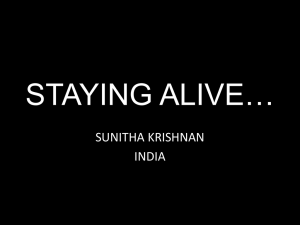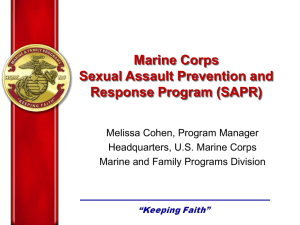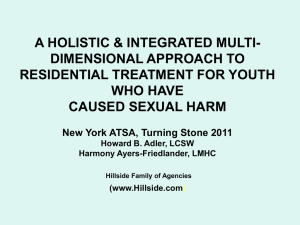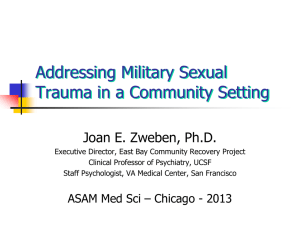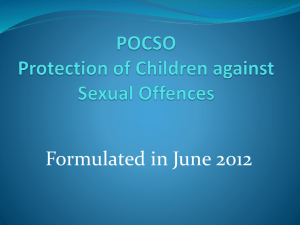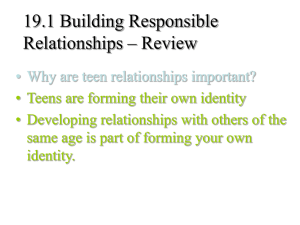Characteristics of Troubled Students
advertisement
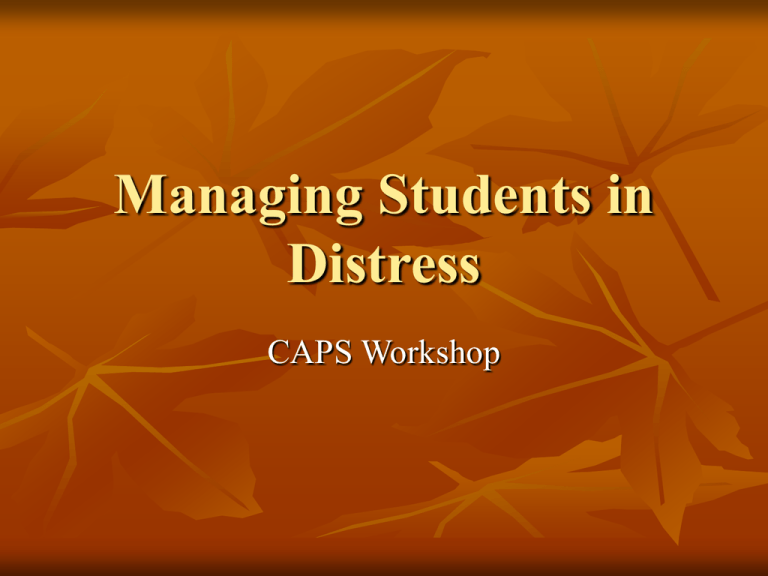
Managing Students in Distress CAPS Workshop Introduction This online workshop is designed for faculty and staff of Mercer University for the purpose of providing some very basic knowledge and tools for assisting students in distress. This workshop offers straightforward advice, techniques and suggestions on how to cope with, intervene, and assist troubled and/or difficult students in or out of the classroom. Characteristics of Troubled Students Persistent feelings of depression, confusion or being upset are signs of troubled students Three levels of student behavior Characteristics of Troubled Students: Level One Behaviors may not be troublesome to others, but they may signal that the student is upset about something: Extremely poor academic performance, or a change from high to low grades Excessive absences, especially if prior class attendance was good Unusual or noticeably changed interaction patterns in the classroom Depressed or apathetic mood, excessive activity or talkativeness, crying, noticeable change in appearance and hygiene, alcohol on the breath Missed tests, or inability to remain awake in class Characteristics of Troubled Students: Level Two Behaviors may signify a high amount of emotional distress that needs to be addressed on a personal, as well as, academic level: Repeated attempts to obtain deadline extensions or postpone tests. New or continuous behavior which disrupts your class or student interactions. Inappropriate or exaggerated emotional reactions to situations, including a lack of emotional response to stressful events. Characteristics of Troubled Students: Level Three Behaviors indicating a student in crisis and needing emergency care: Violent or other extremely disruptive behavior Obvious loss of contact with reality Disturbed speech or communication content Suicidal or other selfdestructive thoughts or actions Homicidal threats Guidelines to follow when you encounter a student in crisis: Remain calm Call the appropriate agency (make sure someone is with the student while calls are being made) Stay with the student until help arrives. Violence and the Verbally Aggressive Student Violence: "To use force so as to injure or damage; roughness in action; to outrage, to force, to injure..." REMAIN CALM; get help if necessary (send a student for other staff/faculty/Chair/Public Safety). Violence, as a result of emotional distress, is rare STAY SAFE (have access to a door, keep furniture/desk between you and the student). Typically occurs when at an intense level of frustration, or of such an enduring nature as to erode all of the student's emotional controls DO NOT THREATEN, CORNER, OR TOUCH THE STUDENT. The adage, "An ounce of prevention is worth a pound of cure," best applies here. Violence and the Verbally Aggressive Student Aggression: "To attack, to go to, to commit the first act of hostility or offense...to assault first or to invade..." Students usually become verbally abusive in frustrating situations they perceive as being beyond their control It is important to remember that, for the most part, the student is not angry with you personally, but at his/her world and that you are the object of pent-up frustrations. Violence and the Verbally Aggressive Student Helpful To: Acknowledge his/her anger and frustration Rephrase what he/she is saying and identify the emotion Reduce stimulation, invite the person to a quiet place, if this is comfortable. Be directive and firm about behaviors you will accept. Allow him/her to vent, get the feelings out, and tell you what is upsetting him/her. Not Helpful To: Ignore warning signs Get into an argument or shouting match. Become hostile or punitive yourself Press for explanations for their behavior. Make threats or dares. Depressed Student Depression is part of a natural emotional and physical response to life's ups and downs Most students will experience periods of reactive (or situational) depression in their college careers. When the depressive symptoms become so EXTREME or enduring that they begin to interfere with the student's ability to function in school, work, or social environment, then the student will come to your attention and be in need of assistance. Students experiencing depression often respond well to a small amount of attention for a short period of time. Early intervention increases the chances of the student's return to previous performance Depressed Student Indicators: Tearfulness/general emotionality Markedly diminished performance Infrequent class attendance Lack of energy/motivation Increased anxiety (generalized, test, performance, etc.) Irritability Deterioration in personal hygiene Significant weight loss or gain Alcohol or drug use Extreme mood swings of emotional highs & lows Depressed Student Helpful To: Let the student know you're aware that he/she is feeling down and you would like to help. Reach out more than halfway and encourage the student to discuss how she/he is feeling. Offer options to further investigate/manage the symptoms of depression. Not Helpful To: Minimize the student's feelings Bombard the student with "fix it" solutions or advice Be afraid to ask whether the student is suicidal if you think she/he may be Suicidal Student Indicators Sleeping much more and later than used to Not sleeping well and waking up early Taking lots of naps Appetite has changed so that the student is not hungry or overeats Withdrawing from friends and family Not attending class Expresses hopelessness or guilt Sudden mood or behavior changes Giving possessions away Expresses that life isn't worth the trouble Suicidal Student Areas that the Counseling Center is adept at exploring with students who are depressed and have some level of suicidal ideation: 1. Do they have a well-developed plan that includes an easily available method? 2. Have they attempted before? 3. Has a friend, family member or acquaintance taken their life through suicide? 4. Do they use substances such as alcohol and other depressants that also can weaken impulse control? Suicidal Student Helpful To: Talk about suicide openly and directly Be confident, caring and know the resources available Take charge and bring the student to the Counseling Center Not Helpful To: Get too involved with the student Ignore comments like, "I won't be a problem much longer” or “Nothing matters; it's no use" Be too busy to intervene Listen to the small voice inside that says, "Something isn't right with this student. " Student in Poor Contact with Reality Difficulty distinguishing fantasy from reality Typically illogical, confused, or irrational thinking Incongruent or inappropriate emotional responses Bizarre and disturbing behaviors Student may experience hallucinations, often auditory, and may report hearing voices (e.g., someone is/will harm or control them). Symptoms can be indicative of a variety of concerns such as, substance use, schizophrenia, delusional disorder, etc. Average age of onset for schizophrenic disorders is within the typical college age range WHILE THIS STUDENT MAY ELICIT ALARM OR FEAR FROM OTHERS, THEY GENERALLY ARE NOT DANGEROUS OR VIOLENT. If you cannot make sense of their conversation, try to consult with or refer to the Counseling Center as soon as possible. Student in Poor Contact with Reality Helpful To: Respond with warmth and kindness. Use firm reasoning. Remove extra stimulation from the environment Acknowledge your concerns and verbalize that they need help Acknowledge their feelings or fears without supporting the misperceptions Acknowledge your difficulty in understanding them and ask for clarification Focus on the "here and now" Not Helpful To: Argue or try to convince them of the irrationality of their thinking (this commonly produces a stronger defense of the false perception). Play along! Encourage further discussion of the delusional processes Demand, command, or order them to do something to change their perceptions Expect customary emotional responses Anxious Student Anxiety is a normal response to a perceived danger or threat to one's well being. In some students the cause of anxiety is clear but it may be difficult to pinpoint in other students. It is important to distinguish true anxiety from normal stress. One or more of the following symptoms may be experienced: rapid heartbeat, chest pain or discomfort dizziness sweating trembling or shaking cold clammy hands difficulty concentrating always being "on edge" having difficulty making decisions sleeping problems Being too fearful to take action In more rare cases, a student may experience a panic attack in which the physical symptoms occur spontaneously and intensely in such a way that the student may fear she/he is dying. Anxious Student Helpful To: Let them discuss their feelings and thoughts. Often this alone relieves a great deal of pressure. Provide reassurance. Talk slowly and remain calm. Be clear and directive. Provide a safe and quiet environment until the symptoms subside. Not Helpful To: Minimize the perceived threat to which the student is reacting. Take responsibility for their emotional state. Overwhelm them with information or ideas to "fix" their condition. Become anxious or overwhelmed. Suspicious Student Usually these students complain about something other than their psychological difficulties. They are tense, cautious, mistrustful, and have few friends. These students tend to interpret a minor oversight as significant personal rejection and often overreact to insignificant occurrences. They see themselves as the focal point of everyone's behavior and everything that happens has special meaning. Usually overly concerned with fairness and being treated equally. Project blame on others and will express anger indirectly. Many times they will feel worthless and inadequate. Suspicious Student Helpful To: Send clear, consistent messages regarding what you are willing to do and what you expect Express compassion without being overly friendly or familiar Be aware of personal boundaries and space when interacting Be aware of your own anxiety about how the student is acting or communicating Let the student know that you are concerned Not Helpful To: Be overly warm or sympathetically close to the student Flatter the student, laugh with them or be humorous Assure the student that you are their friend or advocate Assure them that you will be fair in your treatment of them Student Under the Influence Alcohol is the most widely used psychoactive drug. Preferred drug on college campuses, common to find students who abuse alcohol also abusing other drugs, both prescription and illegal. Fads and peer pressure effect patterns of use. 1999 national study conducted by Harvard School of Public Health determined that 44% of college students engage in binge drinking, which is defined as five drinks in a row (four for women). Student Under the Influence Consuming alcohol in large quantities quickly can be lethal. Other adverse effects include: Hangovers, hospitalization for alcohol overdose, poor academic performance, missing classes, injury, and unprotected sexual activity Prevention strategies have not been very effective in reducing the amount of binge drinking. This may be due to its glamorization at fraternity parties and local bars, which promote happy hours, all-you-can-drink specials, weeknight discounts, and ladies' nights. Student Under the Influence The effects of alcohol on the user are well known Faculty often identify student alcohol abuse when irresponsible, unpredictable behavior affects learning situation or a combination of the health and social impairments associated with alcohol abuse sabotages student performance. 41% of all academic problems stem from alcohol abuse 28% of students drop out because of alcohol. Because of the denial that exists in most substance abusers, it is important to express your concern about the student in terms of specific changes in behavior or performance (not your suspicions about alcohol/drugs). Student Under the Influence Helpful To: Confront the student with the behavior that is of concern. Address the substance abuse issue if the student is open and willing. Offer support and concern for the student's overall wellbeing. Suggest that the student talk with someone about these issues and maintain contact with the student after a referral is made. Not Helpful To: Convey judgment or criticism about the student's substance abuse. Make allowances for the student's irresponsible behavior. Ignore signs of intoxication in the classroom. Student Who Has Been Sexually Assaulted Rates for sexual assault in this country remain alarmingly high. Recent research suggests that the rate for women who will be sexually assaulted is actually 1 in 3. Rate for men who will be sexually assaulted is 1 in 10. Women are 3 times more likely to be sexually assaulted during the college-aged years (18-22) than any other time in their life. Contrary to popular belief, the majority of rapes/sexual assaults are not committed by strangers. About 80% of sexual assaults are perpetrated by assailants known to the victim. Thus, their feelings of being violated and traumatized are exacerbated by feelings of betrayal and confusion. Student who has been Sexually Assaulted The sexual assault victim will have physical and emotional needs. The individual may have been injured (e.g vaginal tears, bruising, etc), contracted a sexually transmitted disease, or impregnated. The student can be treated for all of these without pressing charges/filing a police report. Emotional effects may take longer to emerge. Student who has been Sexually Assaulted Another complicating issue for sexual assault victims is the decision of whether or not to report the crime to the police. More than any other crime, sexual assault is a violation of the victims' body and sense of personal safety. Victims are often reluctant to press charges for fear that they will be further opened to scrutiny by peers, family, the community, etc. It is important to let victims know that a report to the police does not mean they must press charges. It simply leaves the door open to pressing charges later. Further, a victim can receive counseling, and/or medical attention without pressing charges. Student who has been Sexually Assaulted The rape/sexual assault victim may experience any number of reactions. Reactions may occur immediately, or may emerge as time goes on. It is common for victims to re-experience many reactions on, or near, the anniversary of the event, or when exposed (such as through the news, etc.) to a similar event. Some common reactions: numbness, headaches, nightmares, anxiety, sleeplessness, sexual inhibition, distrust of others, guilt, shame, anger, feeling "dirty", denial, withdrawal from others, relationship conflict, flashbacks, fear of being alone, or difficult concentrating. This list is not exhaustive; there is no "one" way a victim will react. Student who has been Sexually Assaulted Helpful To: Be supportive Communicate that the victim is not responsible for the violation Allow the victim to regain their control by making his/her own decisions Inform the victim of available services and offer to contact these services, or accompany the student to the Counseling Center/Health Services Not Helpful To: Encourage/seek retribution Ask the victim how he/she "let" this happen or encouraged the victimization Express your anger toward the assailant Pressure the victim to make a report Assume that you know how the victim feels, even if you have had a similar experience Students Experiencing Trauma Related Stress Individuals who have experienced a traumatic event oftentimes suffer psychological stress related to the incident. In most instances, these are normal reactions to abnormal situations. While some students may be able to cope effectively on their own, others may not. Students Experiencing Trauma Related Stress Normal Reactions Immediately Following a Traumatic Event Stunned, Numb, Confused Bewildered Impaired reasoning Agitated Perspiring Trembling Feeling weak Nauseous Intense anxiety Weeping, screaming Distracted Stoic Students Experiencing Trauma Related Stress Strategies that can help alleviate the emotional pain that students may feel during trauma or crisis: Make personal contact (Ask name and offer your name) Provide place for people to gather and share information and support Help with physical comfort (water, hot drink, snacks, etc. can feel nurturing and supportive) Provide information if you have accurate source. If possible help student get in touch with family (offer office phone if possible) Listen carefully to what students have to say. Don't take their frustrations or other feelings personally. Don't tell the student that "You're lucky it wasn't worse." Convey your understanding and empathy of their experience. Allow the student to have some time to himself/herself. Encourage the use of friends/family and other support networks. Link to follow-up services (Counseling Center, Health Center, etc.) Students Experiencing Trauma Related Stress Longer term issues: Traumatic events can affect an individual's "world view." After the initial shock phase, they may wish to talk about how things are different. They may feel less safe and more vulnerable. The unpredictability of life can overwhelm and leave one feeling despondent or "what's the use." People may need to rebuild their assumptions about the world and their place in it. This is challenging, even frightening, but with the proper support people can usually work things out. Students Experiencing Trauma Related Stress Warning Signs of Trauma Related Stress Recurring thoughts or nightmares about the event. Trouble sleeping or changes in appetite. Experiencing anxiety and fear, especially when exposed to events or situations reminiscent of the trauma. Being on edge, easily startled or becoming overly alert. Feeling depressed, sad, and having low energy. Experiencing memory problems including difficulty in remembering aspects of the trauma. Feeling "scattered" and unable to focus on work or daily activities. Difficulty making decisions. Feeling irritable, easily agitated, or angry and resentful. Feeling emotionally "numb," withdrawn, disconnected or different from others. Spontaneously crying, feeling a sense of despair and hopelessness. Feeling extremely protective of, or fearful for, the safety of loved ones. Not being able to face certain aspects of the trauma, and avoiding activities, places, or even people that remind you of the event. Conclusion We hope you have found this online workshop to be helpful. If you have questions, concerns, or you need further information about these or other topics, please contact us at CAPS (x2862). Please remember that you do not have to handle troublesome situations with students on your own. CAPS' psychologists are available to consult with you or otherwise offer assistance.
